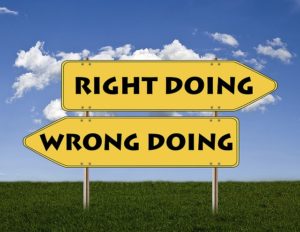Choosing right leadership behaviors in every interaction becomes increasingly important as you move up.
You’re constantly in the spotlight, even when you don’t see the light. The stories about what you say, your tone, your emotional state, what you do and what you don’t do take on a life of their own. So it’s important to be mindful about aligning your behaviors, intentions and highest aspirations at all times.
This requires paying attention in the moment, then consciously choosing right leadership behaviors.

Two simple questions will help.
Choosing Right Leadership Behaviors: Question 1
Can it wait?
- How important is it to do or say anything right now?
- What are the consequences of not reacting now and responding more thoughtfully later?
If the building is on fire, react quickly. Unless the situation leads to dire consequences if you don’t act quickly, take a moment, and a breath, to align your response with your intentions and aspirations.
Vignette
Eric headed straight to the office after a long flight and no sleep. He was tired, short on patience, and at risk for reacting in ways he would later regret. During a late afternoon executive team meeting, Dave, a direct report, called out one of his colleagues for a less than stellar new product roll out. He had violated newly established team norms.
We are an interdependent team, not a collection of individuals. Together we are responsible for the business, each other’s success and the organization’s health. Supporting behaviors include:
- One person’s problem is everyone’s problem.
- We solve problems together.
- We give each other direct and honest feedback.
- No blaming.
- No finger pointing.
- No throwing each other under the bus.
Hearing Dave’s comments, Eric felt his chest hardening and his heart pounding. Anger was on the scene. Eric took a breath and asked himself what might happen if he reacted and what might happen if he waited.
Reacting at the moment would be a clear message that this type of behavior was unacceptable. At the same time, Eric would be demonstrating these very same behaviors. He feared not reacting would send the wrong message, but decided the message could wait.
Eric spoke with Dave privately. He firmly and calmly explained why he chose not to address the situation during the meeting. He asked Dave to talk with his peers about the situation and their conversation. Knowing Eric and Dave had spoken would lend more clout to the message.
Choosing Right Leadership Behaviors: Question 2
What’s the upside? What’s the downside?
The upside//downside question comes to you by way of a high tech executive I have the pleasure to work with and learn from.
Vignette
When Henry weighs the upside versus the downside of having a drink or two with customers and/or team members, the downside wins. Loosening up over drinks increases the potential to say something that could be misinterpreted by those who are a little loose themselves.
On one occasion the upside weighed more and Henry decided in favor of the drink.
Henry’s company is near wine country. When an important new customer, and wine connoisseur, asked about a local vineyard, Henry arranged a dinner tour. The upside was significant, besides, Henry’s really good at swishing and spitting.

